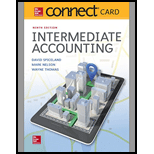
Concept explainers
Perpetual and periodic inventory systems compared
• LO8–1
The following information is available for the Johnson Corporation for 2018:
| Beginning inventory | $ 25,000 |
| Merchandise purchases (on account) | 155,000 |
| Freight charges on purchases (paid in cash) | 10,000 |
| Merchandise returned to supplier (for credit) | 12,000 |
| Ending inventory | 30,000 |
| Sales (on account) | 250,000 |
| Cost of merchandise sold | 148,000 |
Required:
Applying both a perpetual and a periodic inventory system, prepare the
Periodic Inventory System: Under this system, the balance of the merchandise inventory is not adjusted when the purchases and sales takes place, rather it is adjusted at the end of a particular period on a periodic basis.
Perpetual Inventory System refers to the inventory system that maintains the detailed records of every inventory transactions related to purchases and sales on a continuous basis. It shows the exact on-hand-inventory at any point of time.
To Prepare: the journal entries for the given transactions under perpetual and periodic inventory system.
Explanation of Solution
Prepare the journal entries for the given transactions under perpetual inventory system.
Purchase:
| Date | Account Title and Explanation | Post Ref. |
Debit ($) |
Credit ($) |
| Inventory | 155,000 | |||
| Accounts Payable | 155,000 | |||
| (To record the purchase of inventories on account) |
Table (1)
- Inventory is an asset and increased by $155,000. Therefore; debit the inventory account with $155,000.
- Accounts payable is a liability and increased by $155,000. Therefore, credit the accounts payable account with $155,000.
Freight:
| Date | Account Title and Explanation | Post Ref. |
Debit ($) |
Credit ($) |
| Inventory | 10,000 | |||
| Cash | 10,000 | |||
| (To record the freight cost) |
Table (2)
- Inventory is an asset and increased by $10,000. Therefore; debit the inventory account with $10,000.
- Cash is an asset and increased by $10,000. Therefore, credit the cash account with $10,000.
Purchase Returns:
| Date | Account Title and Explanation | Post Ref. |
Debit ($) |
Credit ($) |
| Accounts Payable | 12,000 | |||
| Inventory | 12,000 | |||
| (To record the return of inventories on account) |
Table (3)
- Accounts payable is a liability and decreased by $12,000. Therefore, debit the accounts payable account with $12,000.
- Inventory is an asset and increased by $12,000. Therefore, credit the inventory account with $12,000.
Sales:
| Date | Account Title and Explanation | Post Ref. |
Debit ($) |
Credit ($) |
| Accounts Receivable | 250,000 | |||
| Sales Revenue | 250,000 | |||
| (To record the sales on account) |
Table (4)
- Accounts Receivable is an asset and increased by $250,000. Therefore, debit the accounts receivable account with $250,000.
- Sales Revenue is a revenue that increases the equityby $250,000. Therefore, credit the sales revenue account with $250,000.
| Date | Account Title and Explanation | Post Ref. |
Debit ($) |
Credit ($) |
| Cost of Goods Sold | 148,000 | |||
| Inventory | 148,000 | |||
| (To record the cost of goods sold) |
Table (5)
- Cost of Goods Sold is an expense that decreases the equity by $148,000. Therefore, credit the cost of goods sold account with $148,000.
- Inventory is an asset and decreased by $148,000. Therefore, creditthe inventory account with $148,000.
Year-end Adjusting Entry:
NO ENTRY IS REQUIRED.
Prepare the journal entries for the given transactions under periodic inventory system.
Purchase:
| Date | Account Title and Explanation | Post Ref. |
Debit ($) |
Credit ($) |
| Purchases | 155,000 | |||
| Accounts Payable | 155,000 | |||
| (To record the purchase of inventories on account) |
Table (6)
- Purchase is an expense and increased by $155,000which decreased the equity. Therefore, debit the purchase account with $155,000.
- Accounts payable is a liability and increased by $155,000. Therefore, credit the accounts payable account with $155,000.
Freight:
| Date | Account Title and Explanation | Post Ref. |
Debit ($) |
Credit ($) |
| Freight-in | 10,000 | |||
| Cash | 10,000 | |||
| (To record the freight cost) |
Table (7)
- Freight-in is an expense and increased by $10,000which decreased the equity. Therefore, debit the freight-in account with $10,000.
- Cash is an asset and increased by $10,000. Therefore, credit the cash account with $10,000.
Purchase Returns:
| Date | Account Title and Explanation | Post Ref. |
Debit ($) |
Credit ($) |
| Accounts Payable | 12,000 | |||
| Purchase Returns | 12,000 | |||
| (To record the return of inventories on account) |
Table (8)
- Accounts payable is a liability and decreased by $12,000. Therefore, debit the accounts payable account with $12,000.
- Purchase returns is a contra-purchase account (with normal credit balance) and increased by $12,000. Therefore, credit the purchase returns account with $12,000.
Sales:
| Date | Account Title and Explanation | Post Ref. |
Debit ($) |
Credit ($) |
| Accounts Receivable | 250,000 | |||
| Sales Revenue | 250,000 | |||
| (To record the sales on account) |
Table (9)
- Accounts Receivable is an asset and increased by $250,000. Therefore, debit the accounts receivable account with $250,000.
- Sales Revenue is revenue that increases the equity by $250,000. Therefore, credit the sales revenue account with $250,000.
Cost of goods sold:
No entry is required for cost of goods sold under the periodic method.
Prepare the year-end Adjusting Entry.
| Date | Account Title and Explanation | Post Ref. |
Debit ($) |
Credit ($) |
| Cost of Goods Sold | 148,000 | |||
| Ending Inventory | 30,000 | |||
| Purchase Returns | 12,000 | |||
| Beginning Inventory | 25,000 | |||
| Purchases | 155,000 | |||
| Freight-in | 10,000 | |||
| (To record the cost of goods sold) |
Table (10)
- Cost of Goods Sold is an expense that decreases the equity by $148,000. Therefore, credit the cost of goods sold account with $148,000.
- Ending Inventory is an asset and increased by $30,000. Therefore, debit the inventory account with $30,000.
- Purchase returns is a contra-purchase account (with normal credit balance) and decreased by $12,000. Therefore, debit the purchase returns account with $12,000.
- Beginning Inventory is an asset and decreased by $25,000. Therefore, credit the inventory account with $25,000.
- Purchase is an expense and decreased by $155,000 which increased the equity. Therefore, credit the purchase account with $155,000.
- Freight-in is an expense and decreased by $10,000which increased the equity. Therefore, credit the freight-in account with $10,000.
Working note:
Calculate the cost of goods sold.
| Particulars | Amount ($) | Amount ($) |
| Beginning Inventory | 25,000 | |
| Add: Purchases | 155,000 | |
| Less: Purchase Returns | (12,000) | |
| Net purchases | 153,000 | |
| Goods available for sale | 178,000 | |
| Less: Ending Inventory | (30,000) | |
| Cost of goods sold | 148,000 |
Table (11)
Want to see more full solutions like this?
Chapter 8 Solutions
Connect Access Card for Intermediate Accounting
- Ansarrow_forwardDavenport Industries is working on its direct labor budget for the next two months. Each unit of output requires 0.48 direct labor hours. The direct labor rate is $9.20 per direct labor hour. The production budget calls for producing 7,200 units in July and 7,800 units in August. If the direct labor workforce is fully adjusted to the total direct labor hours needed each month, what would be the total combined direct labor cost for the two months?arrow_forwardDuring 2018, Dalton Enterprises earned revenues of $95,000, had expenses of $72,000, purchased assets costing $10,500, and paid dividends of $7,200. What was Dalton Enterprises' net income for the year?arrow_forward
 Cornerstones of Financial AccountingAccountingISBN:9781337690881Author:Jay Rich, Jeff JonesPublisher:Cengage Learning
Cornerstones of Financial AccountingAccountingISBN:9781337690881Author:Jay Rich, Jeff JonesPublisher:Cengage Learning Intermediate Accounting: Reporting And AnalysisAccountingISBN:9781337788281Author:James M. Wahlen, Jefferson P. Jones, Donald PagachPublisher:Cengage LearningPrinciples of Accounting Volume 1AccountingISBN:9781947172685Author:OpenStaxPublisher:OpenStax College
Intermediate Accounting: Reporting And AnalysisAccountingISBN:9781337788281Author:James M. Wahlen, Jefferson P. Jones, Donald PagachPublisher:Cengage LearningPrinciples of Accounting Volume 1AccountingISBN:9781947172685Author:OpenStaxPublisher:OpenStax College Financial Accounting: The Impact on Decision Make...AccountingISBN:9781305654174Author:Gary A. Porter, Curtis L. NortonPublisher:Cengage Learning
Financial Accounting: The Impact on Decision Make...AccountingISBN:9781305654174Author:Gary A. Porter, Curtis L. NortonPublisher:Cengage Learning Financial And Managerial AccountingAccountingISBN:9781337902663Author:WARREN, Carl S.Publisher:Cengage Learning,
Financial And Managerial AccountingAccountingISBN:9781337902663Author:WARREN, Carl S.Publisher:Cengage Learning, Accounting (Text Only)AccountingISBN:9781285743615Author:Carl Warren, James M. Reeve, Jonathan DuchacPublisher:Cengage Learning
Accounting (Text Only)AccountingISBN:9781285743615Author:Carl Warren, James M. Reeve, Jonathan DuchacPublisher:Cengage Learning





